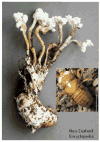A mechanistically novel, first oral therapy for multiple sclerosis: the development of fingolimod (FTY720, Gilenya)
- PMID: 21955849
- PMCID: PMC3694567
A mechanistically novel, first oral therapy for multiple sclerosis: the development of fingolimod (FTY720, Gilenya)
Abstract
Multiple sclerosis (MS) is a chronic autoimmune disorder affecting the central nervous system (CNS) through demyelination and neurodegeneration. Until recently, major therapeutic treatments have relied on agents requiring injection delivery. In September 2010, fingolimod/FTY720 (Gilenya, Novartis) was approved by the FDA as the first oral treatment for relapsing forms of MS. Fingolimod is a novel compound produced by chemical modification of a fungal precursor. Its active metabolite, formed by in vivo phosphorylation, modulates sphingosine 1-phosphate (S1P) receptors that are a subset of a larger family of cell-surface, G protein-coupled receptors (GPCRs) mediating the effects of bioactive lipids known as lysophospholipids. Fingolimod's mechanism of action in MS is not completely understood; however, its relevant biology indicates a fundamentally different mechanism compared to all previously approved MS therapies, with evolving research supporting both immunological and nervous system activities. This duality may herald a paradigm shift in the treatment of MS and other neurological disorders.
Figures




References
-
- Adachi K, Kohara T, Nakao N, Arita M, Chiba K, Mishina T, Sasaki S, Fjujita T. Design, synthesis, and structure-activity relationships of 2-substituted-2-amino-1,3-propanediols: discovery of a novel immunosuppressant, FTY720. Bioorg Med Chem Lett. 1995;5(8):853–856.
-
- Albert R, Hinterding K, Brinkmann V, Guerini D, Muller-Hartwieg C, Knecht H, Simeon C, Streiff M, Wagner T, Welzenbach K, Zecri F, Zollinger M, Cooke N, Francotte E. Novel immunomodulator FTY720 is phosphorylated in rats and humans to form a single stereoisomer. Identification, chemical proof, and biological characterization of the biologically active species and its enantiomer. J Med Chem. 2005;48(16):5373–5377. - PubMed
-
- An S, Bleu T, Huang W, Hallmark OG, Coughlin SR, Goetzl EJ. Identification of cDNAs encoding two G protein-coupled receptors for lysosphingolipids. FEBS Lett. 1997;417(3):279–282. - PubMed
-
- Balatoni B, Storch MK, Swoboda EM, Schonborn V, Koziel A, Lambrou GN, Hiestand PC, Weissert R, Foster CA. FTY720 sustains and restores neuronal function in the DA rat model of MOG-induced experimental autoimmune encephalomyelitis. Brain Res Bull. 2007;74(5):307–316. - PubMed
-
- Baranzini SE, Mudge J, Van Velkinburgh JC, Khankhanian P, Khrebtukova I, Miller NA, Zhang L, Farmer AD, Bell CJ, Kim RW, May GD, Woodward JE, Caillier SJ, Mcelroy JP, Gomez R, Pando MJ, Clendenen LE, Ganusova EE, Schilkey FD, Ramaraj T, et al. Genome, epigenome and RNA sequences of monozygotic twins discordant for multiple sclerosis. Nature. 2010;464(7293):1351–1356. - PMC - PubMed
Publication types
MeSH terms
Substances
Grants and funding
LinkOut - more resources
Full Text Sources
Other Literature Sources
Medical

